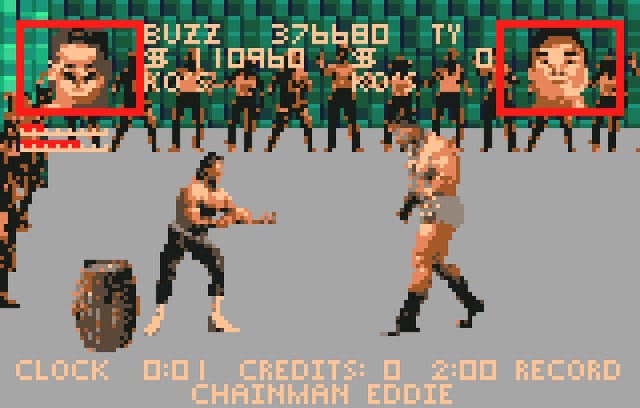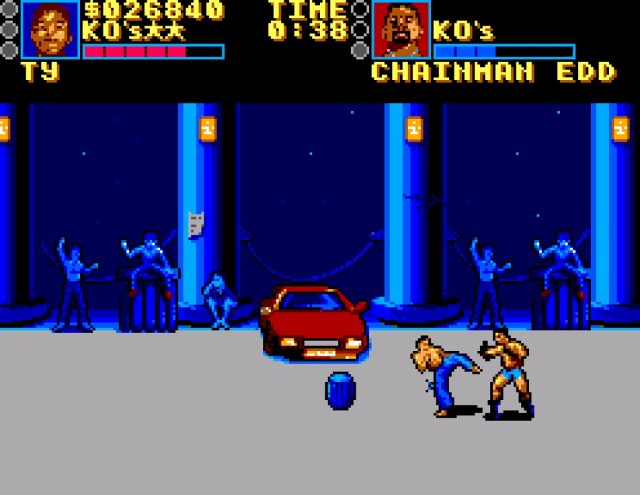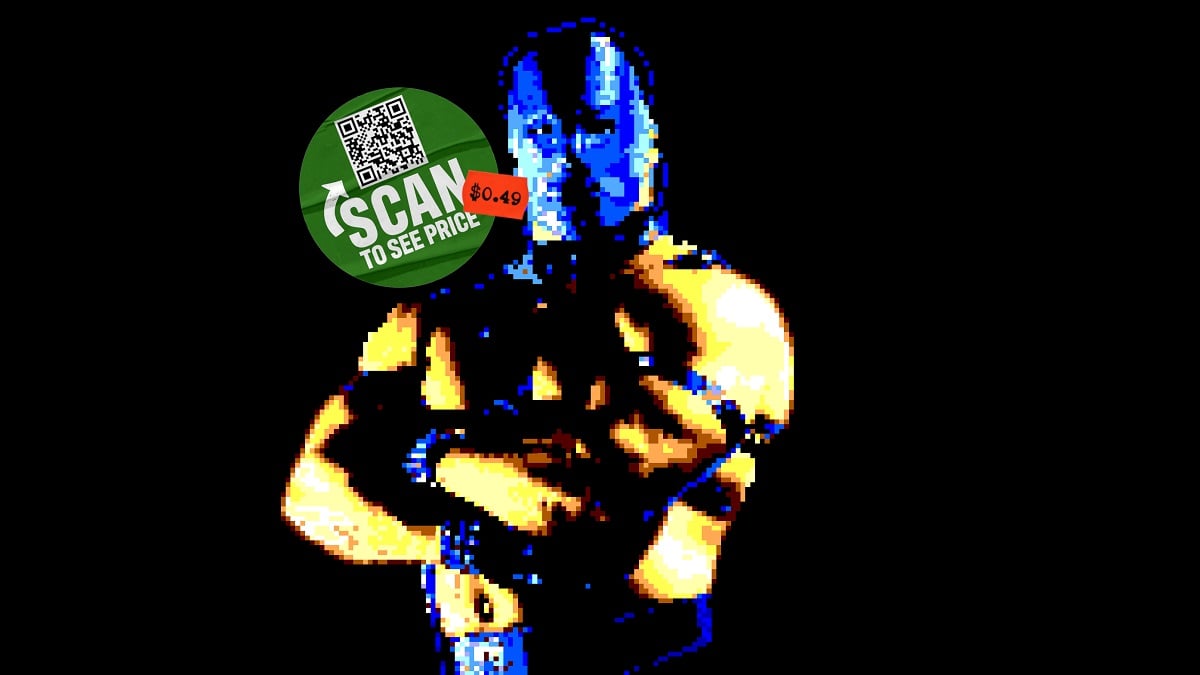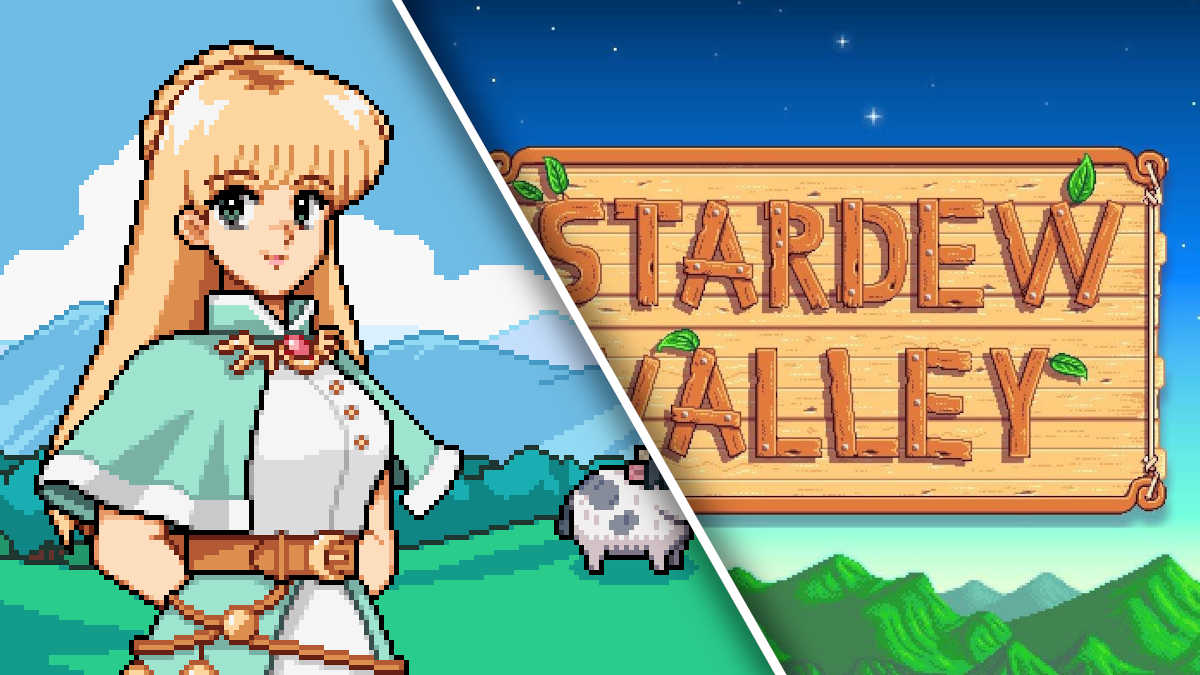Home ports of arcade games can be a bit of a gamble. Often, they’re running on much less powerful hardware, and that can reflect in many different ways on the game. It might have less action, more slowdown, or it could just be a lot uglier. Other times, the home port of a notorious quarter-muncher might be rebalanced for the living room, as is the case with Super Smash T.V. or the NES Contra.
Old ports are also interesting from a design standpoint. Many were done by people who weren’t associated with the original production and didn’t have any access to the original code. They were, in a way, just sketching the closest facsimile they could to the original version. The faithfulness of the port was, therefore, all down to the analytical skills of the developer, as well as their access to the original source material and how many fucks they were willing to part with. Were they actually interested in the work, or were they just trying to get a project done before a deadline?
Pit-Fighter is an interesting example of this, as back when it was released in arcade in 1990, it wasn’t unpopular, but it also wasn’t 1991’s Street Fighter II. So, it was a bit of a crapshoot as to whether or not it was going to get a single decent port. There were a lot of them, and we’re going to take a look.
For simplicity, I’m going to look at the console and handheld ports. There were a number on the various home computer platforms at the time, but after struggling with the Commodore 64 port and having it crash on me midway through a loading screen, I cut my losses. Shame, the ZX Spectrum version is a thing of beauty.

Sega Genesis (1991, Tengen)
The Genesis/Mega Drive version of Pit-Fighter is probably the best of the bunch, and I’m not sure that’s really a compliment. I think my fascination with it is more that it makes the game look magnitudes goofier. The digitized actors have lost a lot of fidelity, so it loses much of the oily BDSM club imagery. However, in its place, the quality and quantity of animation frames haven’t been increased, so everything has this delectable veneer of jank.
You only get three continues in this version, but the combination of easily exploitable moves and the relative passiveness of the opponents make it possible to get to the end. If you had to play a home console port of Pit-Fighter, this one at least meets the “so bad it’s good” threshold. It kind of proves that a bad port of kusoge isn’t necessarily just a bad game; it might just be a new flavor of kusoge.

Super Nintendo (1991, THQ)
Pit-Fighter on SNES had to have been rushed. It released the same year the SNES did, which kind of demonstrates an effort to get it on the market during the fevered euphoria of a new console release. It doesn’t even try to replicate the UI, instead opting for something that looks like it’s from a development build.
The most egregious part about it is the AI, which seems to just be mashing various inputs. They’re extremely aggressive, and then when they get near you, their movements make no sense. They’ll jump randomly and start throwing attacks with no rhyme or reason. Then, once they knock you to the ground, they’ll continue to do little hops between stomping on you. It’s bizarre.
There are also no continues. I had absolutely no hope of making it to the Chainman. I’m not the only one, either, as complaints about the port’s difficulty seem rather pervasive. I searched to see if there was a buried continue input and instead found the advice to just keep mashing R while using Ty to win. Weirdly, I think this is the absolute worst of the versions listed here.

Atari Lynx (1992, Atari Games)
I have a soft spot for the Atari Lynx. It was a battery-sucking handheld you could land a harrier jet on. However, a huge portion of its library was coin-op ports, and that’s kind of what the system was worst at. Nowhere is this more apparent than, perhaps, Pit-Fighter.
The screen is far too low resolution to really depict the game’s digitized actors, but they tried it anyway. As a result, the sprites are pretty dopey looking, and it uses a palette that is largely just greys and beiges. It does try to get the sprite scaling in there, though. As you move further back from the front of the arena, the fighters appear smaller. It’s better to fight closer to the screen since then you can at least make out what things are supposed to be.
Thankfully, that’s an option, since the AI is dumb as rocks. Each fighter’s special move is mapped to the Option 1 button, which means you can just spam it, but I found this to be unreliable. The best way I found to fight is to just stand still and hold down the kick button. It uses a turbo function so once one kick is complete, your fighter immediately launches another one. There are only 6 continues to get you through to the end of the game, which didn’t even come close for me. However, try as I might, I couldn’t find a better strategy than just letting them run into my foot.

Game Boy (1992, THQ)
The port for Nintendo’s monochromatic wonder, the Game Boy, is not as bad as you might think. It plays better than the Atari Lynx version. The AI is more dynamic and closer to the arcade version, and the moves feel more responsive with better hit detection.
The problem is with the graphics. They still try to use the digitized actors, but when you cram too much information on the classic Game Boy’s limited palette, you just get a fuzzy mess. What’s worse is that most of it blends into the background, so the best way to track the combatants is by their much darker pants. It’s like playing a fight between a pair of disembodied pants.
Pit-Fighter is practically incomprehensible on an original model Game Boy. Using a Super Game Boy or Game Boy Advance makes things better, but still not all that great.
I initially thought this version was really difficult. It doesn’t allow you to continue without a code (Hold down and hit A on the game over screen), and when the AI gets the advantage on you, it can really lead to a pounding. But then I once again discovered the technique of letting opponents walk into your outstretched foot. I also iterated on this by pulling off a super kick while an enemy started their animation to get up from being knocked down. They’d stand up right into the kick. It carried me right to the end. That’s how effective it was.

Sega Master System (1991, Domark)
For whatever reason, the Master System version of Pit-Fighter was the one that finally decided to get creative with the graphics in order to better serve the gameplay. It shrinks down all the characters, and the tweaked color palette makes things more legible. The handheld versions probably should have done this, but here we are. It’s a shame that this foundation wasn’t tweaked for a Sega Game Gear version.
On the other hand, it’s not really that much fun to play. I think this is largely because my exploitative strategies don’t work here. The legs of your tiny fighter are much too short to keep their opponent at bay for too long. The Master System controllers only have two buttons (no start or select), so your repertoire is more limited than other platforms. I was at least able to make it up to the Chainman’s stage. I needed to find out how his underwear looks in this art style.
Only released in the UK, the Master System version also has this weirdly enjoyable soundtrack that is credited to “The Doomsday Machine.” It sounds inappropriately chirpy compared to the subject matter, but considering most of the other ports sound horrible, I’ll take it.
A sketch of kusoge
Arcade ports like we saw in the ‘80s and ‘90s are rather rare today. I mean, for one thing, in this part of the world, arcades are practically extinct. But then, they also tend to have more universal hardware powering them and are built on common engines, so it’s less of an issue to transplant them accurately to other hardware. Older games are a different story, as they require some form of emulation. Still, a developer is more likely to release something accurate than to take liberties with a game.
I’m not exactly nostalgic for those days. I hate having to worry about whether or not I’m playing the definitive version of a game. However, there’s a weird creativity that arose from the challenges of transplanting games. Ganbare Goemon on Famicom, for example, was initially an attempt to port Mr. Goemon from arcades and instead mutated into a sprawling series.
More often than not, you just took the version for whatever was your favorite platform at the time. Then, you had to hope that the publisher cared enough about the game to provide you with a reasonable facsimile. Will a version of Space Harrier provide you with a fun experience, or will it be a janky cash grab? That little gamble is often more fun than the version you eventually wind up with, especially in the case of Pit-Fighter.
For previous Weekly Kusoge, check this link!














Published: Jul 24, 2023 9:00 PM UTC